Inputs &
Outputs
with Jeremiah Chiu, Marta Sofia Honer, and Damon Krukowski
The initial idea behind the following conversation was to have someone from the Union of Musicians and Allied Workers (UMAW) speak with an artist on the label about the reality of doing creative work for a living within the current layout of the music business. I also wanted to highlight the fantastic organizational work being done by UMAW and to endorse those efforts in no uncertain terms. After reaching out to the UMAW crew I was even more excited after realizing that one of my formative DIY heroes, Damon Krukowski, was on the zoom call we arranged to discuss the piece. He was a natural fit for what I was envisioning. I sent him some records and press materials and we arranged a time for him to speak with Jeremiah Chiu and Marta Sofia Honer. I decided to keep my beak out of the mix so they could run free, and later that day they sent me a recording of the three of them talking deeply about their creative processes, with almost no reference to political or business concerns. At first I was perplexed, but as the recording played I was so glad. It made perfect sense. This was the conversation they wanted to have and, without knowing it, it was the conversation I wanted to listen to. This was the first piece completed for this second issue of Tracing The Lines, and it informed the entire direction and theme of the collection. So, many thanks for pulling a fast one, Damon. We should still talk about politics sometime though.
—David Brown
Jeremiah & Marta at Public Records. Photo by Alejandro Ayala.
Inputs/Outputs
DAMON KRUKOWSKI
I feel like the record [Recordings from the Åland Islands] is almost in search of inputs. Like, there is a whole list of inputs: the track titles [for instance] are like inputs into the system. And I want to use that concept to talk to you about the way you do your music, because you work with an acoustic instrument and modular synths in combination. So I feel like that might get to the core of how you work.
JEREMIAH CHIU
I like that abstraction, but also how it’s clearly direct and specific. Because it is something that I think a lot of people aren’t working with in the exact same way. No two people are doing it the same in terms of the acoustic and the electronic elements. We play these two instruments and there is a moment where we can find a dialogue between the two qualities of sound that I think is interesting, and oftentimes it’s not obvious or easy to make that sound manifest in a cohesive way. Specifically, with inputs and outputs, I personally was really interested in the work that David Behrman was doing. This great composer that was writing a lot of computer software to interact with live performances. And so you’d have something like a horn player connected to a microphone, or an input, that would then be fed into an algorithm or a software that he wrote that would then react in a certain way. So, there’s this dialogue that starts to happen between the performer and the computer that I thought was really quite musical and interesting, where oftentimes in that setting it could be overly theoretical or not actually sound so great. I was really taken by, especially his record Unforeseen Events, in which there was a really beautiful dialogue between those things. That same approach, I think, happens for us with the modular synthesizer. Where, for me, there is a sense of establishing some parameters but then of course allowing for some chaos to ensue. Which then you [to Marta] kind of harness or control.
[TO MARTA]
I don’t know what your thoughts are about that. Inputs and outputs.
MARTA SOFIA HONER
Well, that’s the eternal question, right? How to meld the two, acoustic and electronic. We’ve tried a variety of things. We’ve done performances in the past where I am doing a lot more things with pedals. We’ve tried more little mini synths built into pedals for me to run through, that didn’t quite have the quality I was looking for. Obviously, on the record I primarily sound very acoustic, but one thing that we’re doing now that I really enjoy, that kind of ties into where Jeremiah ended up, is that we’re running my acoustic sound straight into his modular. Where he’s live-capturing some of my sounds and then I am reacting to that. So I’m often doing lead lines off of whatever bed of myself gets created, which is different every time.
JC
There were also a lot of moments in the process of making that record in which we gave ourselves this parameter of saying whatever we had improvised and happened to catch while we were on those trips are the bedrock or the foundation of what we’re using. Rather than going back into a studio and rerecording/recapturing etc. Let’s work specifically from this because there is something about that input that I think people will hear in the output. Which is that the air of the room, of the space, of the improvised moments, or the subtle and sort of really intimate moments that were captured by field recordings, etc. And what you [to Marta] did a lot of in the post production was reperformed some of your performances using granular synthesis.
MSH
Yes...so, he would use the original input, right? And then we’d see how you could create something new but still have that organic original essence in it. So yeah, there are a few lines in the record, and some other instrumental parts of recordings we captured where, within granular synthesis use, we were able to make other phrases and melodic lines.
DK
So then you’re transposing it into a different kind of voice at this point? Or are you still using your viola when you were doing that?
MSH
Still using viola.
JC
But we did do some of that translation to midi.
MSH
Yeah, that’s true. Sometimes we would take the line and convert it to midi so that we could basically use that original foundation but then attach a new sound to it.
JC
Different textures to it.
MSH
Yeah, different texture to it. Then I did the same thing. My dad had visited us and had recorded some stuff for us, improvising off of some of our material. And then–the same thing– within granular synthesis, I took some of his flute lines and kind of layered them and looped them. Which is on “Archipelago” I believe.
DK
Oh cool. So you used your dad as a studio player?
MSH
Yes
JC
Ya. [laughs]
DK
Session from dad. That’s exactly what I was kind of feeling from the record. It could be a very abstract exercise, like you’re saying about David Behrman, but it’s very organic, and to me very diaristic. It feels very much like you take us on your journey, or your time spent in the Åland Islands. It’s probably because of the field recording, of course, because you give us snippets of real time recording that you’ve obviously done on location. But it’s in the music too. Something I really appreciate in the way that it’s orchestrated and arranged is that I lost track, often, of what was the field recording and what you were either processing or also responding to, or inputing separately, from the field recording. And I really enjoyed that it’s not a mix. It’s more like a confusion. It just sort of moves from one to the other. To the point where it doesn’t feel like, “Oh, field recordings with electronics over them,” which I feel like that’s a process that people have done a lot. But this is very different. I feel like you’re in dialogue with your own source material.
JC
I mean, I think that’s exactly it. Another reference point that was really influential is the [early] records that Franco Battiato was making, that were really these combinations of incredible melody and song that are confronted with musique concrete style collaged aspects– now you’re all sudden in a kitchen in, you know, an Italian household or something. There’s these huge shifts that happen but they feel, in the pacing, like a scene cut. And feel, really, that it places you, versus forcing a field recording to be a bed or the foreground or background to something else. And I think that, certainly listening to a lot of different things, you kind of hear the ways that things will naturally blend together. And I think, intentionally, we’re always looking for a little bit of that rub. That also just makes it feel unique to what the field recordings or the improvisations or instrumentation need in the sense that you really have to listen to them. And they’re not foreground/ background, but they’re actually all active participants in the arrangement. So I really like balancing that stuff in a way that forces everything to the foreground, and it is that sound, and it is the piece itself.
PLACE
DK
I was listening to a lot of field recordings during lockdown. I don’t know, I think probably others were drawn to the same thing.
JC
Yeah I think so. [laughs in affirmation]
DK
Back when we really couldn’t go anywhere at all, I started to find myself listening to–especially on the BBC Radio– they have fantastic field recordists working, that they’re broadcasting all the time. And I found it very satisfying, the sort of aural visits to places that I couldn’t be at that moment. I was also listening to a lot of what people often call ambient music, but certainly instrumental music during lockdown. I think that also was kind of common. But what you’ve made is something that actually requires traveling–it’s very unlocked down– but it is made up of these elements that I was very drawn to in isolation. So I really appreciate it again, that this was sort of a very social record.
JC
The record is that experience. And I think that, in some ways, we’ve focused a lot on trying to make sure the narrative flows so that anyone can sort of transcend without having to go specifically to that place– that it actually brings you into a different space.
TIME
JC
The pace of the record is very specific in the sense that the pace of that place is extremely slow. It’s glacial. And so that’s one aspect of it that really carries through. We can’t really speed anything up, because that’s just not what it is. You know? There is something about time that transports, you know, the expanse of time there.
DK
Totally, I mean, that’s what also brings it into the realm of improvisation and of live performance. There is a feeling of real time throughout, not just the field recordings, obviously, but also your playing. You’re using electronics, but you are not removed from real time. And that, to me, is rather unusual.
CONTEXT, HUMANS, PRECISION
JC
I think that’s the main thread for me personally, that I’m working on with the electronics, is that I’m intentionally moving into the space of improvisation, of playing with other musicians and instrumentalists that oftentimes operate in more like a jazz context, or improvised music, or an experimental music context. Specifically because electronic music, historically, is very– it’s on the clock, right?
It’s literally on a clock. And the flexibility of that is challenging, to bend that time. And the thing that I loved about hearing, for example, old Raymond Scott recordings or any of these early synthesists is that there’s still a very human element to all of it. And that’s what I want to maintain, or retain, or learn to do, is really bring the humaneness into the realm of the electronic. So that you recognize that there’s still somebody manipulating this in real time, that it’s an instrument that’s being played. I think you really do hear that with early 70s and 80s synthesizer music, but less and less so today. Once you get into the realm of extreme fidelity and precision you kinda lose that human looseness. It can be algorithmically programmed, and velocities can be programmed, but it’s not the same. The accidents don’t happen. The switches– you don’t hear a flick, you know. And I really love that sound.
DK
It’s interesting to me that your references are all pre-computer.
[all laugh]
DK
And of course, what’s remarkable about your setup, there’s no computer on stage.
SCREENS
MSH
Oftentimes after we are editing something, and crafting something, and say “Let’s sit back and listen to it.” Jeremiah’s always like “don’t look! Don’t look at it while we listen back.”
DK
You can misjudge so much... if you’re hearing something that’s off, it’s so easy to misidentify it visually.
JC
I mean, that’s the whole thing. You’re crafting a narrative and telling a story. And with that the cadence and timing is everything. The pace of it has to feel natural. And when you look at something visually, and try to hear it, it’s not the same as you just actually experiencing that vibration and air and saying, “This is that precise moment that things need to change or move.” And in practice, it gets us more and more used to seeing with our ears, right? We can visualize or hear or be in that space.
DK
Yeah, it’s a body thing, too. I mean, back when everything was tape, when I first started recording, there were definitely these physical gestures that you’d have for punching in, for example. You had to feel the groove and you had to feel the anticipation in a sort of conductor-y way. You just had to be a little bit ahead to punch it in so the machine could have its own little pause there. To get inside it.
LIMITATIONS
JC
There’s a lot of hardware that is pretty advanced these days. And I think that with the computer, you can certainly do anything with it. And to me, that’s the problem I have with it, is that I really approach synthesizers as instruments. And an instrument sort of has finite limitations. So then, you really learn its bounds, and then you push against those bounds. And with the computer, that’s sort of infinite. There’s never really the same learning. Because you can always achieve a breakthrough where you’re like, “Okay, now I’ve opened another door and through that door is another door.” And so what do I do? I know a lot of very talented software-based computer artists that do incredible stuff with it. But for me, there’s something that forces me to work in a different way. This is the limitation of this piece of hardware. And I’ve really found my way in and out of it and its nuances. But also, I really can get into the moments of this where it kind of breaks down. I really like that moment. So then it does feel like an instrument. Because when I’m performing I don’t always want to be looking at the thing. To me, touching a knob or working with a fader is a real interaction. You don’t get the same haptics when you’re touching a screen or clicking a mouse. Those are two different feelings, you know?
PRESETS, IMPROVISATION
DK
On an analog board, you zero it out after everything you do and then you have got to start all over again. I’m wondering if that’s true for your mutual setup, between the two of you. You have your inputs determined to some degree, where they’re coming from. But are there presets? Or is it kind of zeroed out every time you do this?
JC
There’s not many presets. There are samples that we reuse, of course, to execute certain things, but the performance is something that we have to reel in every time that we’re doing it. Last year, we had played all these shows–they were all sort of nuanced in different ways–and I remember our last one that we had done at the Columbia Experimental Music Festival in Missouri. That one hit. And it hit in a different way. Where we found each other in the performance.
MSH
Yea, I agree. We obviously have the framework, and yes, there are some samples that are preset and some sequences that are preset. But there’s always that big element of improvisation and live-capture happening. Then playing off of that capture and the energy of the performance in the room in general. Some of the things that captured, and how we approached that performance last year at that festival did create some new sounds for us that we had never heard before in any of our sets during that year of touring the record. And then consequently, the tail end of the set created some new material that we had never done before. Which was a really fun way to end a long run of shows and then still find something new at the end of it. And then, of course, it was like, “Oh, we should do that again!”
DK
Yeah, I always feel like that’s the moment when you need to make a new record.
(MORE) LIMITATIONS
MSH
The synthesizer is just like, funny enough, an acoustic instrument in that temperature affects it, right? It sometimes takes awhile for the oscillators to warm up. You know, a room can effect, and humidity can affect my instrument. I kind of know their tendencies now. So there are some sequences where I know, “Hey, this is coming up.” And have actually, within practice, figured out that I actually have to tune. I mean, I haven’t calculated exactly how many cents. But I know certain pitches, if I want to line up with them, I do have to tune let’s say six cents sharp to make it sound like we’re cohesive. Which personally, I would like it to sound cohesive.
DK
That’s amazing. I think at that point you probably create a cohesion that’s greater than you ever could without that kind of fluctuation. That makes complete sense. So it’s literally just the analog circuitry, just the electronics reacting to humidity or temperature or...?
JC
It depends. Some days, they’re more or less stable than other days. If it gets too hot, or something, some things will just start to pitch up or down. And you’re just kind of reeling that in. That’s also what makes it alive. It makes it feel like you’re actually just working with electricity as the instrument. It’s quite fun that it’s not exacting every single time. Because, then it doesn’t have this quality that it’s phoned in, and it is what it is, and it’s this sort of identical character. But, it is something that you’re in dialogue with.
(MORE) INPUTS / OUTPUTS, (MORE) IMPROVISATION, (MORE) TIME
JC
There’s a couple modules in the modular synthesizer that take live capture. Basically, I have it set up so that in my mixer I have all the auxiliary sends sending to different places. So either their effects modules or sampling ones. And, on the fly I can just send any input to any sampler or effects and then capture that live and then feed it back into the output. I like to keep [that] really improvisational because you never capture exactly the same amount of time, or same performance each time. And when you turn that volume pot to bring it in, you’re like, “what is it going to sound like?” Really gotta leave that up the chance. And then we have to be really attentive in listening in that moment. “Okay, how do we play against this now? Or where’s this gonna take us?” So that’s maybe what Marta was mentioning with that last performance, is that it went in a direction that we hadn’t heard before in a year long of touring.
DK
To my ear you’re not looping, in the way that people talk about looping. Are you?
JC
No, not really looping. Because I let them kind of roam freely. I’m not clocking them the same way. There’s a great musician, Pauline Anna Strom. RVNG Intl. put out a compilation of her works recently. And when I listened to her work, it’s all these synthesizers that are all running on different times. They kind of meld together in this really natural way that I think is incredibly beautiful. And so, I also really liked that dialogue between different instruments, where it’s like you’re running on your own time. But, you kind of find these moments where they kind of link up again. You hear that stuff with Terry Riley or Steve Reich or any of those recordings, where they kind of just all flow, they phase. They phase with each other.
DK
And create pulses within there that are not a clock. Or, it’s creating its own clock out of the collision of the phasing.
DK [TO MARTA]
Are you changing your viola sound as you [operate your live setup]? Or are you triggering samples?
MSH
It’s primarily triggering samples. I do have some samples of myself in there. So there are moments where like, I’ll play a line, I also have that same line that I’ve recorded before, that’s in the bank. And Jeremiah has the same one as well. And then he can also live capture it. And so then all of a sudden, we have like four modes of the same thing that could potentially interact with each other.
DK
Right, that’s really cool. But they’re distinct. They’re coming in at different places. Again, the inputs are separate. So you’re not just playing along and having it processed. It’s being split into four or something like that.
MSH
Yeah, yeah. Lives in four different places.
RHYTHMS, TIME (CONTINUING)
JC
There’s a couple of sequencers that are running different patterns for different oscillators. I’ll basically tighten or loosen the envelopes of them, so they feel more or less rhythmic versus tonal. I really kind of play with filters when we’re playing live to see: are there moments where a new tonality will appear? Or polyrhythms? Marta will tell you that I have trouble with four. With the time signature 4/4.
DK
Well, it’s a tricky one.
JC
It’s not in me. I’m always pushing something over four. I really love polyrhythms. And I think that it’s really nice when you find a couple of moments of two different filters that all of a sudden feel like one instrument. And then, they’re hitting each other in a polyrhythm where you’re like, “I don’t know where the one is anymore.” And just kind of riding that wave.
DK
Marta, then do you have to find the one or do you give up?
MSH
No. I mean, I know where we are. It’s more like when we are in the composition process, he’ll try to immediately stray us away from any cut time common way that it might be counted. Or we’ll have something that’s relatively locked in and then there’s been times where we’re rehearsing and I’m like, “Wait a second, we had this thing. We figured it all out.” And then all of a sudden I can’t actually find the one really anymore–like, my part–then he’ll be like, “Oh yeah I changed the baseline. So now it’s a random pattern.”
JC
Sort of the opposite of the Bootsy approach. “Do anything and always hit the one.” I’m like, “Do anything.”
(MORE) CONTEXT, PERSONA
DK [TO MARTA]
You have an incredible list of [studio] credits. I went searching to try and connect [that work to the work with Jeremiah] and I’m curious how you connect the two for yourself. When you do studio work, are you given charts mostly? What’s the process for you?
MSH
For the most part, yea, most of it is charts and it is kind of the opposite of everything we’ve spoken about so far. Very locked in, always playing to the click. I do a lot of remote recording at my home studios and editing all of that down, obviously. So a lot of staring exactly at everything I have recorded over and over, especially when tasked with doing a lot of stacking and kind of filling out the entire string section, to make sure that everything lines up and it’s cohesive. Currently there’s not a huge bridge for me. They really live in separate worlds. There are a few moments where they start to overlap. We’ve gotten the chance now to work a little bit on some film projects. I’ve done some studio work for other International Anthem artists, writing some strings and recording some stuff for that at home. But it is very separate music. Media music–music written for film and TV–is really precise and exact. And it serves a different purpose. It serves often as an underscore and to serve a picture or a story. Whereas when we’re writing music together it’s creating a story. And that’s all in one and it’s its own thing.
DK
So that’s really fascinating though, Marta. So you have to be your own string section, essentially, a lot of the time, it sounds like. So do you use different instruments? Or do you pitch your main instrument up and down to reach other registers?
MSH
I use different instruments. I play violin as well. If I’m tasked with doing a big cue, obviously, they’re sending over all the parts. Like I said, I’m usually just the session musician versus the composer, but I’ll be playing violin and viola. I have a couple of instruments. I have a bunch of different bows. And then when it is these big orchestral sections, I have a little system that I do where I work by slightly pivoting around the microphone to avoid feedback. I have a little lineup of imaginary players trying to play like a different person every time. So again, when you’re playing, it doesn’t sound like 12 mes on top of each other. Because that’s not what a section of twelve players would sound like.
DK
That’s great. Who are your other players? Do you cast their horoscopes?
MSH
No, I should. I mean, there’s definitely some that are a little more forward. But it’s just a system of the performance where I’m trying to really emphasize what’s on the page dynamically and with the vibrato and the presence. And then there’ll be ones where there’s no vibrato, changing fingerings and different strings.
DK
That’s so cool. Well, I see a bridge there. Just in that minute exploration of subtleties in a given performance of the same line, even if you’re doubling. But I love the idea that you’d have different personalities too, of course, different touch on the instrument. Because that’s how you get an actual sum of a section together, right?
I don’t know if you know the Portuguese writer from the 20th century called Fernando Pessoa. He was a writer who wrote under many, many different names. He didn’t call them pseudonyms. He called them heteronyms, because he thought they were all each not him. They were different. They were maybe aspects of him but they were characters that he completely kept track of. He did cast horoscopes for them, for example. They had different names, but also they spoke different foreign languages from one another. So they had different literary influences. One loved Walt Whitman and was able to read English and one was very French, and that kind of thing. And he published poems under each of these personalities. And then he wrote prose as well. And his prose! It’s hard to put your finger on who’s really speaking anymore, because this becomes more like the string section I think that you’re creating.
MSH
[The system is] called ABCDE right now.
DK
Just flesh that out a little bit. Costume changes? I mean, at least different shoes. I would think that would change your whole posture.
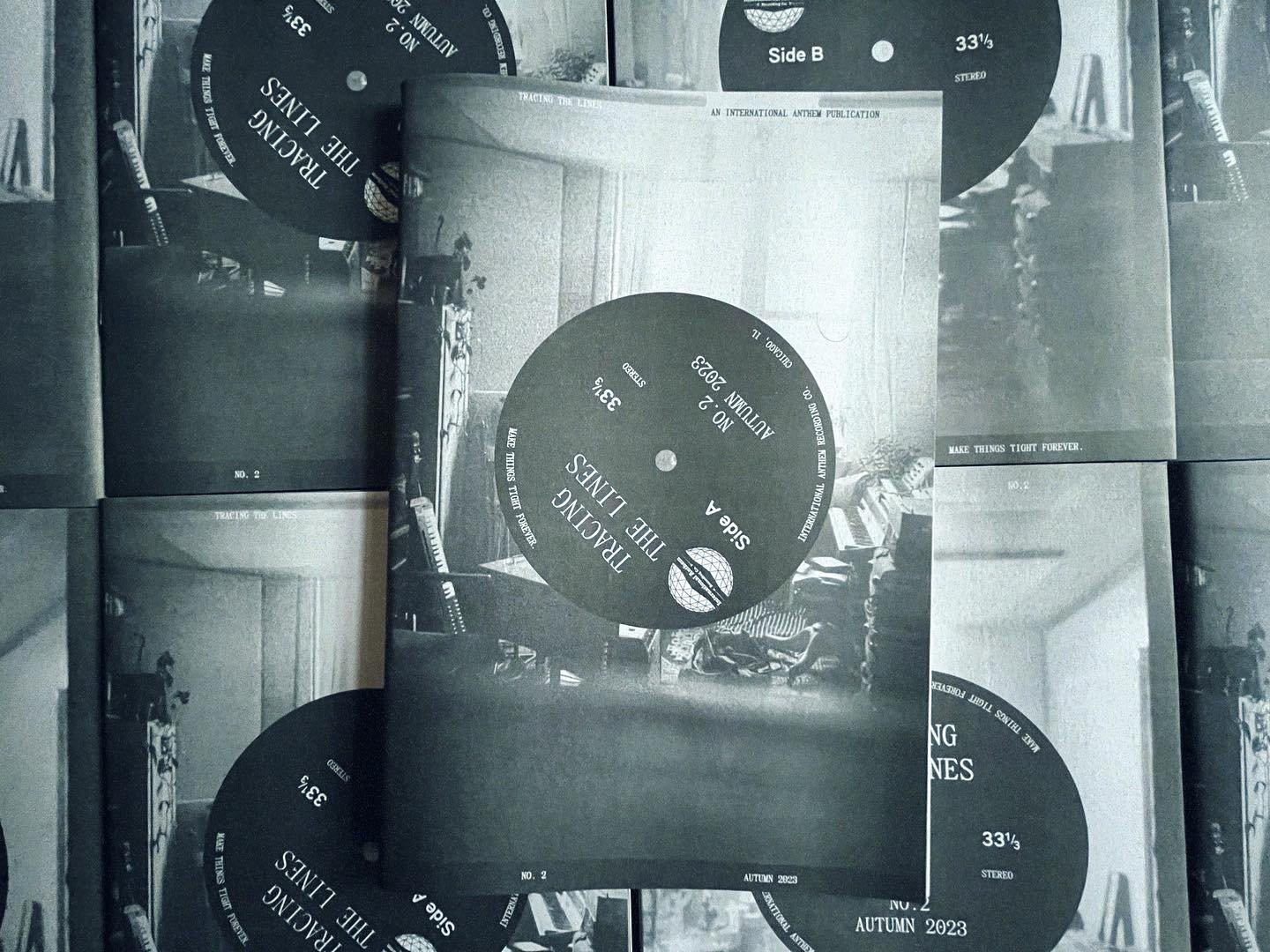
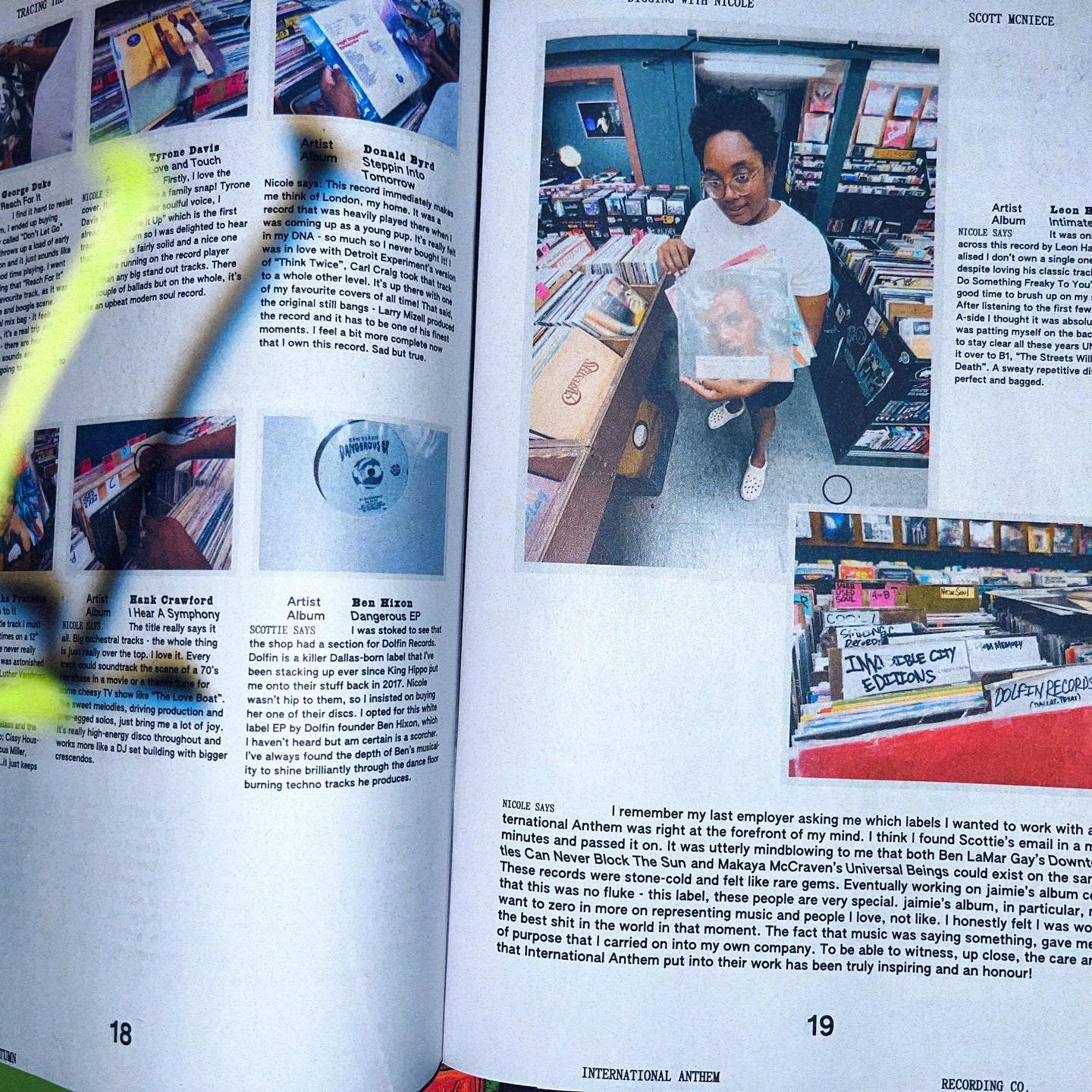
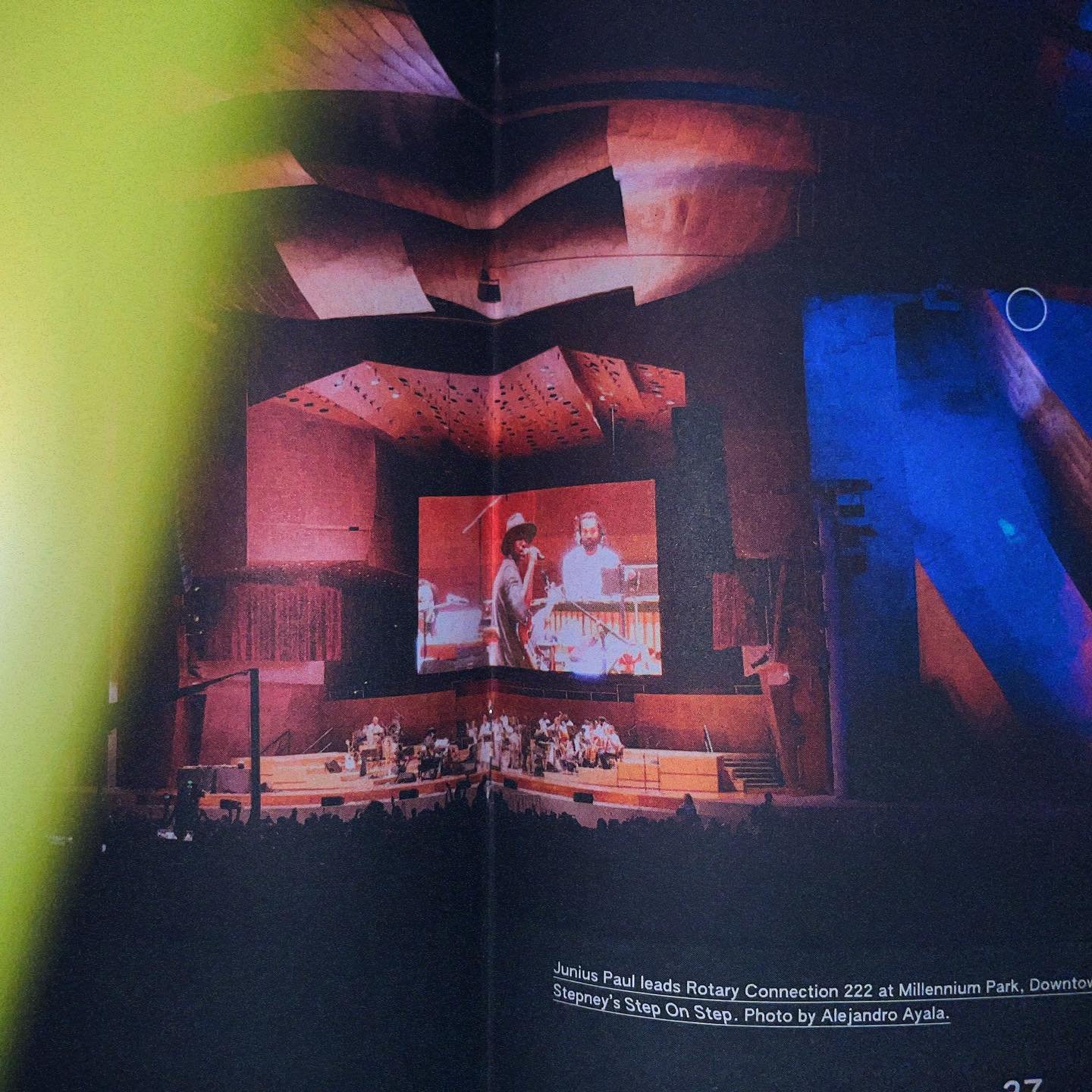
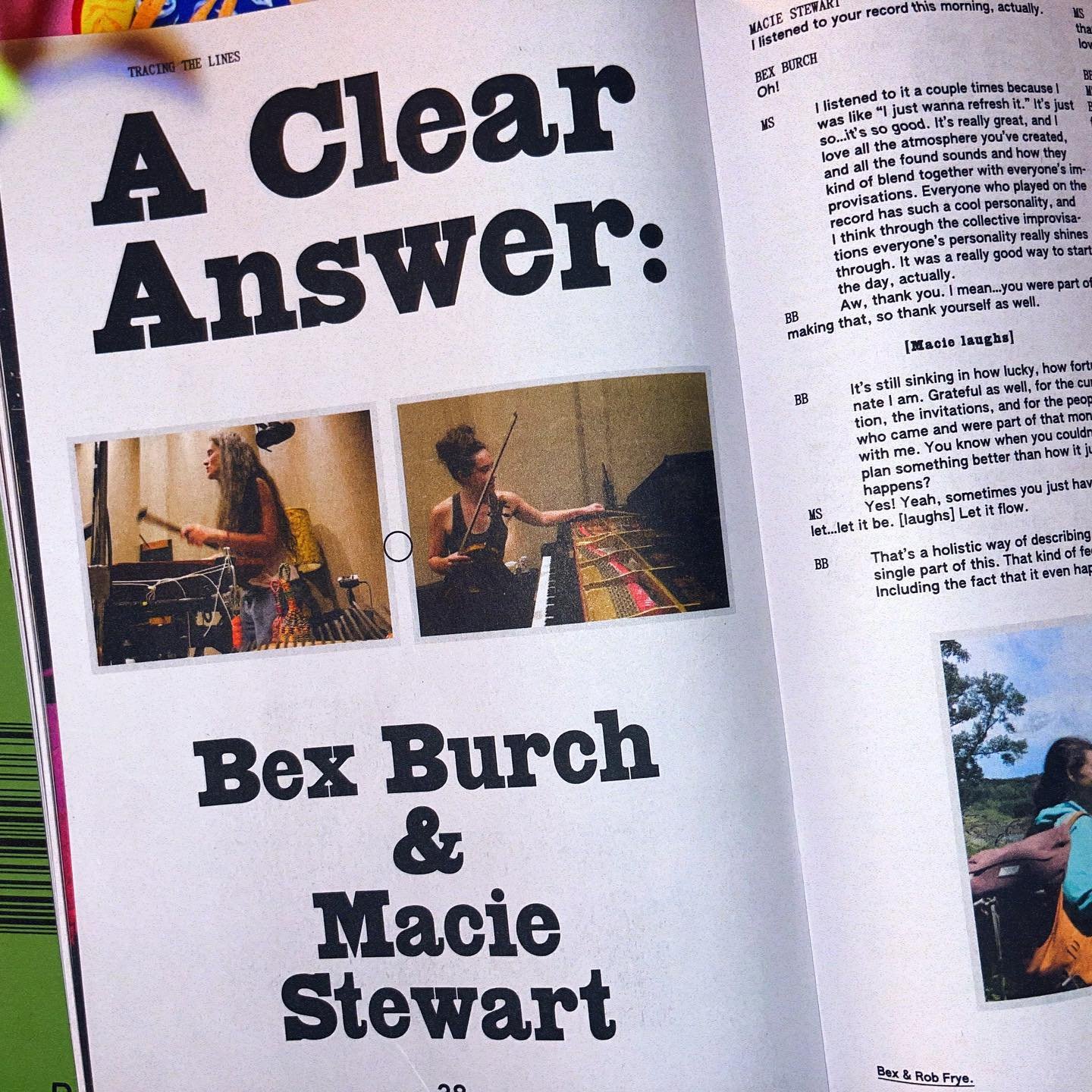
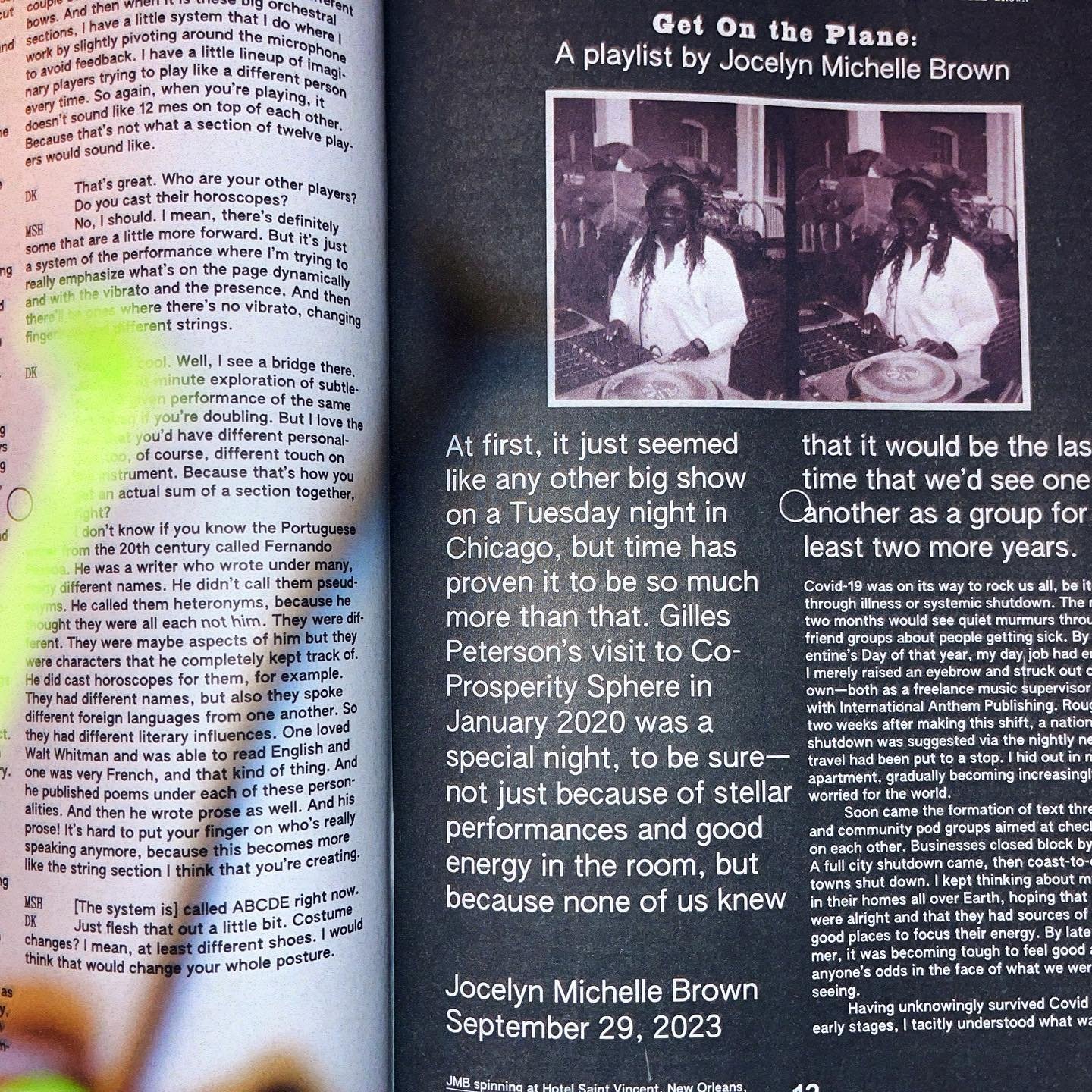
Tracing The Lines is a creative exploration of International Anthem Recording Co. and the community that surrounds it.
Issue #2
The 72-page 170x250mm newsprint zine, printed in the UK on 70gsm stock, was edited by David Brown and designed by Jeremiah Chiu with contributions from:
Alabaster DePlume, Alejandro Ayala, André 3000, Ariana Lebedev, Ash Knotek, Ayana Contreras, and more!



